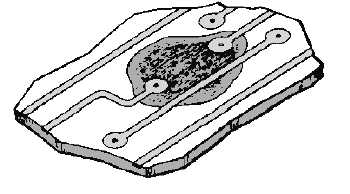3-37
2.
Repairable delaminations not extending to the edge of the circuit board should be cut away by
abrasive methods until no delaminated material remains.
3.
Delaminated material is not removed if it is repairable.
4.
After all damaged board material is removed, the edge of the removed area is beveled and
undercut to provide holding points for the repair material.
5.
Solvent is used to clean thoroughly and to remove all loose particles.
6.
A compound of epoxy and powdered fiberglass is mixed and used to fill the cutaway area.
7.
The epoxy repair mixture is cured according to the manufacturer's instructions.
8.
The surface of the filled area is leveled after the compound is cured.
9.
If delaminations extend to the edge of the board, the delaminated layers are filled completely
with the repair mixture and clamped firmly together between two flat surfaces.
10.
After the cure is completed, abrasive methods are used to smooth the repaired surface to the
same level as the original board.
11.
If necessary, needed holes are redrilled in the damaged area, runs are replaced, eyelets and
components are installed, and the area is cleaned. Figure 3-30 shows the repaired area ready for
components.
Figure 3-30.—Repaired board ready for components.
Q29. List three causes of damage to printed circuit boards.
Q30. What is the preferred method of repairing cracked runs on boards?
Q31. Damaged or missing termination pads are replaced using what procedure?
Q32. How is board damage caused by technicians?
Q33. What combination of materials is used to patch or build up damaged areas of boards?

